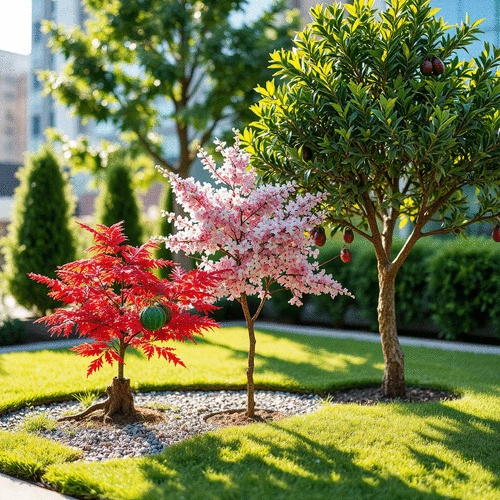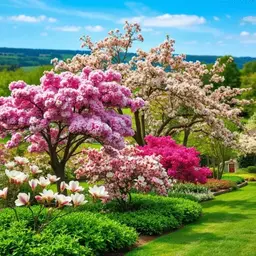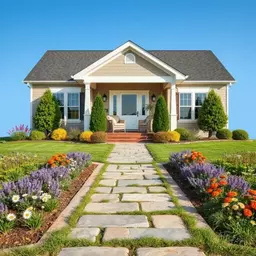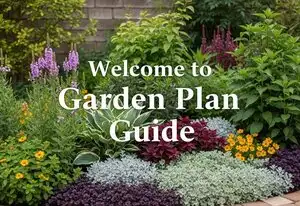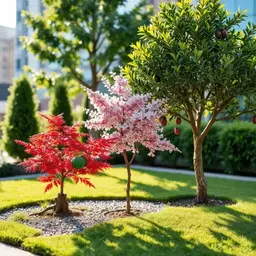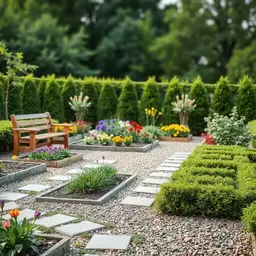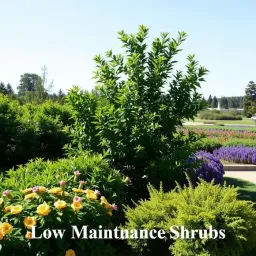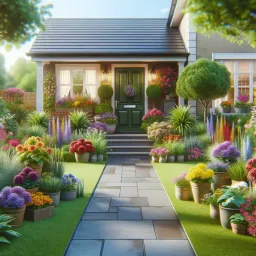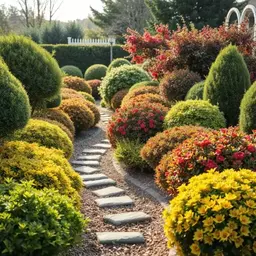Ever wondered how a well-placed tree can transform not just your garden, but your entire urban environment? The right tree can provide beauty, shade, and even support local wildlife, making your outdoor space a thriving ecosystem. Discover how tree selection is the key to a successful urban garden!
What You Will Learn
- The importance of selecting compact trees to fit limited urban spaces without overcrowding.
- How to assess environmental conditions such as sunlight, soil quality, and pollution when choosing trees.
- The benefits of incorporating native trees to enhance biodiversity and support local wildlife.
- Considerations for non-native trees, including potential maintenance and environmental impact issues.
- The significance of ornamental value and seasonal interest for creating a captivating garden landscape.
- Utilizing visual aids and infographics to streamline the tree selection process and gardening care.
Native vs Non-Native Decorative Trees
Understanding the advantages and challenges of choosing between native and non-native trees is essential for urban gardening success. For guidance on selecting the perfect trees for visual appeal, explore our article on enhancing curb appeal with trees.
Benefits of Native Trees
- Supporting Local Wildlife: Essential habitat and food sources.
- Improved Biodiversity: Maintains natural balance.
- Lower Maintenance Needs: Requires less water and chemicals.
- Enhanced Soil Health: Improves soil structure and nutrient cycling.
Considerations for Non-Native Trees
- Invasive Tendencies: Can outcompete local plants.
- Increased Maintenance: Requires more water and pest control.
- Compatibility Issues: May not thrive in local climate.
Understanding the Importance of Tree Selection in Urban Gardens
When we think of urban gardens, we often picture a patch of green in a concrete jungle. However, choosing the right trees is crucial for creating a successful and inviting urban space. Trees not only add beauty but also provide shade, improve air quality, and offer habitats for wildlife. In this article, I'll help you understand why tree selection matters and how to navigate the challenges of small urban gardens.
Challenges of Small Urban Gardens
Urban gardening comes with its own set of unique challenges. Space is often limited, and the environment can be harsh for plant life. Understanding these challenges can lead to more thoughtful decisions when selecting trees for your garden.
Space Limitations and Urban Constraints
Many urban gardens are small, so selecting trees with a compact growth habit is essential. This ensures that your trees will fit comfortably in the available space without overcrowding other plants. Considerations like canopy spread and height are vital; we want our gardens to flourish, not feel cramped! For more ideas on how to maximize your green space, consider exploring small yard curb appeal tips.
- Opt for trees that grow upwards rather than outwards.
- Choose varieties that won't outgrow your space quickly.
- Look for trees that can be pruned to maintain their size.
Environmental Considerations in Urban Settings
Urban environments come with tricky conditions—think of pollution, heat islands, and compacted soil. Trees in these settings need to be resilient and adaptable. Choosing the right species can make all the difference for their survival and growth. Native trees often perform well because they're accustomed to local conditions, while some non-native species might struggle or require extra care.
- Assess sunlight availability in your garden.
- Understand the soil quality and moisture levels.
- Factor in air pollution levels and choose trees that can withstand it.
Key Characteristics of Decorative Trees for Urban Spaces
Now that we’ve looked at the challenges, let’s dive into what to look for in decorative trees for your urban oasis. Selecting trees that fit your space while enhancing your garden's visual appeal is essential. With the right knowledge, you can create a stunning landscape that thrives in an urban environment!
Compact Size and Growth Habit
Choosing trees with a compact size is crucial for small urban gardens. They should fit within the confines of your space without overwhelming it. This way, you'll have a garden that feels open and inviting.
Choosing Trees with a Small Footprint
Look for trees that won’t take over your garden! Some excellent options include dwarf varieties or trees bred specifically for small spaces. These trees will not only fit neatly but will also add character and charm to your garden.
- Dwarf Alberta Spruce
- Japanese Maple
- Crabapple
Understanding Canopy and Root System
Besides size, paying attention to the canopy and root system is essential for urban tree selection. A tree with a shallow root system can adapt better to compacted urban soils, while a well-structured canopy can provide shade without overwhelming your garden space. Finding balance is the key! Learn more about decorative trees for small gardens that suit various needs.
- Opt for trees with a moderate canopy spread.
- Choose trees with non-invasive roots.
- Consider how the tree's shape complements your garden design.
Ornamental Value and Aesthetic Appeal
Beautiful trees can elevate your small urban garden into a stunning retreat. Selecting trees with ornamental value will ensure that your garden looks captivating year-round.
Flowers, Foliage, and Seasonal Interest
Look for trees that provide vibrant flowers in spring, lush foliage in summer, and stunning colors in fall. This variety will keep your garden engaging throughout the seasons. Plus, trees that boast seasonal interest can become focal points in your garden!
- Eastern Redbud for beautiful spring blooms.
- Flowering Dogwood for elegant summer flowers.
- Crape Myrtle for colorful summer blooms.
Bark Texture and Color Variations
Don’t forget about bark! Trees with interesting bark can add visual texture to your garden, serving as eye-catching elements even in winter. Choosing trees with varied bark colors and textures will enhance the overall aesthetic.
- Consider trees like the London Plane for unique bark patterns.
- Look for varieties with peeling bark for added interest.
- Incorporate trees that have contrasting colors to your landscape.
Quick Summary
Here's a brief recap of the key points discussed so far:
- Choosing the right trees is vital for urban gardens to enhance beauty, provide shade, and improve air quality.
- Space limitations and environmental challenges necessitate careful tree selection to ensure growth and sustainability.
- Native trees offer benefits like supporting local wildlife and requiring lower maintenance compared to non-native species.
Comparing Native and Non-Native Decorative Trees
When it comes to selecting decorative trees for your urban garden, understanding the differences between native and non-native species can make a world of difference. Each type has unique benefits and challenges that can impact not just your garden’s aesthetics but also its overall health and sustainability. So, let’s dive into the advantages of incorporating native trees into your urban oasis!
Native trees are those that naturally grow in your area and have adapted to the local climate, soil, and wildlife. By choosing these trees, you're not only enhancing your garden’s beauty but also supporting the local ecosystem. Imagine creating a space that invites native birds and insects to thrive, all while enjoying the stunning colors and textures these trees bring!
Benefits of Native Trees in Urban Ecosystems
Native trees are like the superheroes of urban gardening! Here are some key benefits that make them stand out:
- Supporting local wildlife: Native trees provide essential habitat and food sources for various birds, butterflies, and beneficial insects.
- Improved biodiversity: By planting native species, you help maintain the region's natural balance and encourage a variety of life forms to flourish.
- Lower maintenance needs: Native trees are well-adapted to local conditions, often requiring less water and fewer chemicals compared to non-native varieties.
- Enhanced soil health: These trees improve soil structure and nutrient cycling, which benefits the entire garden ecosystem.
By choosing native trees for your urban garden, you’re taking an eco-friendly approach that can be incredibly rewarding! It’s fulfilling to witness the positive impact you’re making on the environment right outside your door.
Considerations for Non-Native Trees
While non-native trees can be beautiful additions to your landscape, there are some important factors to keep in mind. Let’s explore the potential risks associated with these species:
- Invasive tendencies: Some non-native trees can outcompete local plants, leading to a decline in biodiversity.
- Increased maintenance: Non-native species may require more water, fertilizers, and pest control, which can be burdensome for urban gardeners.
- Compatibility issues: These trees might not thrive in your local climate, leading to poor growth and limited aesthetic appeal.
To enjoy the best of both worlds, consider integrating a mix of native and non-native trees in your garden. This way, you can appreciate diverse aesthetics while also nurturing the local ecosystem. Remember, every choice you make in your garden has a ripple effect—let’s make it a positive one!
Visual Engagement and Resources for Urban Gardeners
In the world of urban gardening, visual aids can be a game-changer! They help make complex information easier to digest, allowing you to plan your space more effectively. To keep your gardening journey engaging, let’s explore some visual resources that can enhance your experience.
From colorful infographics to detailed diagrams, using visuals can elevate your garden design process. Think of them as your trusty companions as you navigate the choices ahead! For more ideas on how to plan your garden space effectively, check out our beginners guide to garden layout.
Utilizing Infographics and Visual Aids
Infographics are fantastic tools for urban gardeners, offering quick glimpses into essential aspects of tree selection and care. Here are a few examples of what to look for:
- Seasonal interest timelines: These show when various trees bloom, helping you plan for year-round beauty.
- Size comparisons: Visualizing how big trees will grow helps you choose the right fit for your garden.
- Care guidelines: Infographics can outline the watering and maintenance needs for different species, making care easy to follow.
Using these visual tools can significantly boost your confidence and inspire creativity as you design your urban garden. Don't hesitate to explore various resources and see what sparks your imagination!
Incorporating Testimonials and Case Studies
Nothing inspires quite like hearing from fellow gardeners! Incorporating real-life examples of successful urban gardens can be both motivating and informative. Here’s how you can use testimonials:
- Learn from experiences: See what worked (and what didn’t) for others in similar urban settings.
- Visual inspiration: Pictures of flourishing gardens can ignite your creativity and give you practical ideas to implement.
- Build community: Connecting with other gardeners creates a supportive network where you can share tips and encourage one another!
At Garden Plan Guide, we love sharing stories from our community and showcasing the transformative power of trees in urban spaces. Every garden tells a story—what’s yours going to be?
Key Takeaways and Encouragement for Urban Gardeners
As we wrap up this exploration of decorative trees for urban gardens, it’s essential to reflect on your personal gardening goals. Choosing the right tree for your space can significantly impact both aesthetics and environmental health. Think about what you want to achieve and how trees can enhance your outdoor experience!
Choosing the Right Tree for Your Space
With so many options available, it’s crucial to consider your garden’s unique characteristics. Here are some guiding questions to help you decide:
- What is the size of your garden space?
- How much sunlight does your garden receive?
- What is your primary objective—shade, beauty, or attracting wildlife?
Taking the time to reflect on these questions will guide you toward making informed decisions that align with your vision. Remember, gardening is a journey, and every step you take contributes to creating your dream outdoor space!
Call to Action: Start Your Urban Gardening Journey
Are you ready to dive into the world of urban gardening? There’s no better time to start than now! Begin by sourcing your favorite decorative trees, and don’t hesitate to explore local nurseries for native options. Remember, the right support can make all the difference! For guidance on selecting the best plants for your garden, consider our article on selecting low-maintenance landscaping plants.
At Garden Plan Guide, we’re here to help you every step of the way. Check out our resources for planting tips, care guides, and community stories that will inspire you. Together, let’s grow beautiful urban gardens that reflect our love for nature and creativity!
Recap of Key Points
Here is a quick recap of the important points discussed in the article:
- Choose compact trees for small urban gardens to maximize space utilization.
- Consider environmental factors such as sunlight, soil quality, and air pollution when selecting trees.
- Opt for native trees to support local wildlife and reduce maintenance needs.
- Select trees with moderate canopy spreads and non-invasive root systems to ensure compatibility with your garden.
- Incorporate trees with seasonal interest to enhance the aesthetic appeal of your garden throughout the year.
- Utilize visual aids and infographics to simplify the tree selection process and boost your gardening confidence.
- Engage with the gardening community for inspiration and support as you embark on your urban gardening journey.
Frequently Asked Questions About Urban Tree Selection
- Q: Why is tree selection important for urban gardens?
- A: Choosing the right trees is crucial for urban gardens because they not only add beauty but also provide shade, improve air quality, and offer habitats for wildlife. Careful selection ensures the trees thrive despite space limitations and harsh urban environmental conditions.
- Q: What are the main challenges of urban gardening when it comes to trees?
- A: The main challenges include limited space, which necessitates compact growth habits, and harsh environmental conditions such as pollution, heat islands, and compacted soil. Trees need to be resilient and adaptable to these factors.
- Q: What are the benefits of choosing native trees for an urban garden?
- A: Native trees support local wildlife by providing essential habitat and food sources, improve biodiversity, require lower maintenance (less water and chemicals), and enhance soil health because they are naturally adapted to the local climate and conditions.
- Q: What should I consider when selecting non-native trees?
- A: When selecting non-native trees, consider their potential invasive tendencies (they might outcompete local plants), increased maintenance needs (more water, fertilizers, pest control), and compatibility issues with the local climate, which could lead to poor growth.
- Q: How can visual aids help in urban tree selection?
- A: Visual aids like infographics, seasonal interest timelines, size comparisons, and care guidelines simplify complex information, helping urban gardeners plan their space more effectively, choose the right fit, and understand maintenance needs. They boost confidence and inspire creativity.

